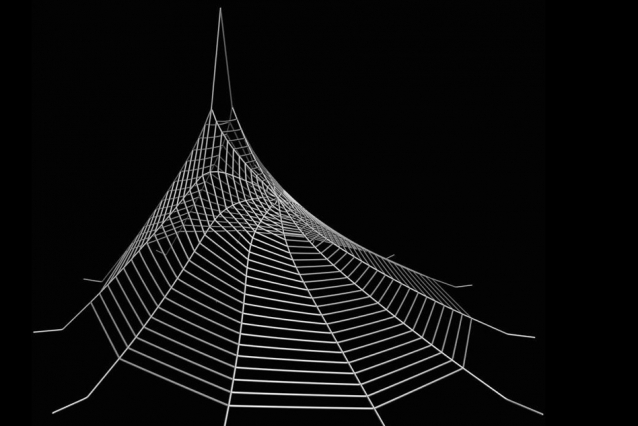May 20 2015
Spider silk has been widely researched for its superior material properties and attractive structure. It is known to be stronger than steel. MIT researchers in particular have explored its uniqueness to enable the probable creation of artificial resources capable of imitating natural silk’s amazing properties.
 Scientists at MIT have developed a systematic approach to research the structure of spider silk, blending computational modeling and mechanical analysis to 3D-print synthetic spider webs. (Courtesy of the researchers)
Scientists at MIT have developed a systematic approach to research the structure of spider silk, blending computational modeling and mechanical analysis to 3D-print synthetic spider webs. (Courtesy of the researchers)
The most recent research conducted by MIT researchers focuses on developing a methodical approach to study the spider silk’s structure by integrating mechanical analysis and computational modeling to 3D-print artificial spider webs. These models will reveal the ways in which spiders develop their webs.
“This is the first methodical exploration of its kind,” says Professor Markus Buehler, head of MIT’s Department of Civil and Environmental Engineering (CEE), and the lead author of a paper appearing this week in Nature Communications. “We are looking to expand our knowledge of the function of natural webs in a systematic and repeatable manner.”
The team was able to directly manufacture and test artificial web structures by design by integrating emerging microscale 3D-printing methods with multiscale modeling. The results procured from this study are likely to be used for harnessing the strength of the spider silk for many other applications, and initiate a way to digitally develop novel structures and composites with qualities such as damage-resistance and reliability.
The paper was written by Buehler, along with CEE research scientist Zhao Qin, Harvard University professor Jennifer Lewis, and former Harvard postdoc Brett Compton.
The MIT researchers were also able to discover a major connection among the web structure of spiders, the point of loading , and mechanisms related to failure. They observed the way the spider adjusted the silk distribution throughout the whole web, thereby enabling the spider to enhance the strength of its web for its expected prey. The experimental setup employed by the team included 3D-printed artificial webs using metal structures, and then combining their data into models.
“Ultimately we merged the physical with the computational in our experiments,” Buehler says.
According to Buehler, spider webs utilize very less quantity of material to trap prey of varying sizes. He and the team hope to utilize this concept to prepare artificial, lower density, damage-resistant materials.
Lewis states that the 3D-printed models paved the way for analyzing how the web structure impacts strength and damage tolerance, which would not have been possible using natural spider webs.
“Spider silk is an impressive and fascinating material,” she says. “But before now, the role of the web architecture had not yet been fully explored.” Lewis’ aim was to examine the spider web’s geometric aspects by using similar material to silk, which can be 3D-printed with consistent mechanical properties.
The orb-weaver spider webs were the inspiration behind Buehler’s team to develop 3D designs. They managed to control the thread’s diameter based on a technique comparing heterogeneous and homogeneous thread thickness across all their samples.
In simulation, the team created ‘the ideal environment to test and optimize the web structures’ under different loading conditions, and then use synthetic materials to print identical webs, Qin says. “We are on the way to quantifying the mechanism that makes the spider’s web so strong,” he says.
The MIT study reported that spider webs with even thread diameters tend to handle force applied at one area e.g., impact from flies striking against webs, in better manner. Similarly, spider webs with non-uniform diameters are capable of handling widespread pressure caused by elements such as rain, gravity or wind.
The integration of 3D-printing with computational modeling enables testing and improving designs in an efficient manner.
“This work is an excellent demonstration of how we can exploit designs in nature in the development of novel materials and structures.” says Sandra Shefelbine, an associate professor of mechanical and industrial engineering at Northeastern University not involved in this work.
Marc Meyers, a professor of mechanical and aerospace engineering at the University of California at San Diego, adds: “Biological materials and structures are the new frontier of engineering. This most recent significant contribution by Markus Buehler and colleagues goes beyond the first stage, which is to understand nature, and make significant inroads into creating a bioinspired structure.”
Lewis states that going forward the MIT team will focus on investigating the web’s dynamic aspects using controlled impact and vibration tests. She believes that this would allow alteration of the properties of the printed material in real time, thereby leading to the printing of enhanced, multifunctional structures.